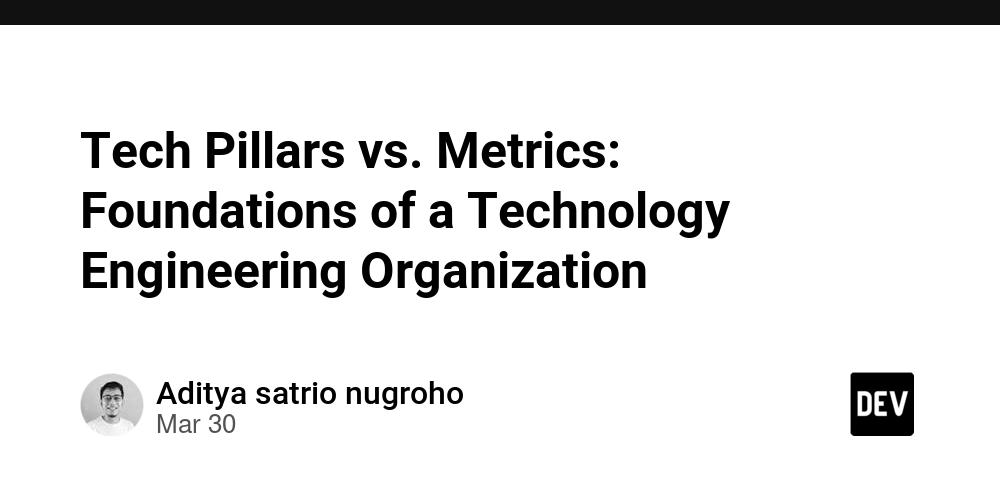Tech Pillars vs. Metrics: Foundations of a Technology Engineering Organization
Why This Matters As engineering leaders, we often operate in high-velocity, high-uncertainty environments. Our teams are shipping fast, but are we improving sustainably? Without clearly defining the strategic priorities (pillars) and measuring them effectively (metrics), we risk optimizing the wrong things—and building tech that's brittle, expensive, or misaligned with business goals. This article serves as a framework to build a structured, metrics-driven engineering culture rooted in clear, strategic pillars. It's written for tech leadership who want to scale with intention. 1. What Are Tech Pillars? Tech pillars are non-negotiable strategic truths for your engineering organization. They represent core domains of focus that support the long-term viability, performance, and alignment of the tech org. They aren't measured directly, but instead guide decision-making, investment, and cultural behaviors. Example Tech Pillars: System Reliability & Observability Engineering Productivity & Developer Experience (DX) Cost Efficiency & Resource Optimization Performance Optimization Quality, Stability & Security Innovation & Technical Growth Cross-Team Collaboration & Alignment Analogy: Think of pillars like the foundation of a building. You don’t measure the pillar itself; you check for cracks in the walls, leaks in the ceiling—the symptoms of a failing pillar. Reference: Forsgren et al. (2018, Accelerate) describe these as "capability domains" predictive of software delivery and organizational performance. 2. What Are Metrics? Metrics are the gauges, dials, and warning lights of your engineering organization. They provide quantifiable feedback on how well you’re upholding each pillar. Metrics are only meaningful when tied to a strategic context. Measuring uptime means little unless it serves your Reliability pillar. Tracking PR merge time without pairing it with review quality might be counterproductive. Examples of Metrics (Grouped by Pillar): System Reliability & Observability Uptime % Mean Time to Detect (MTTD) Mean Time to Recovery (MTTR) Incident Recurrence Rate Engineering Productivity & DX Cycle Time Lead Time for Changes PR Review Time Deployment Frequency Developer Satisfaction Score Cost Efficiency & Resource Optimization Cost per User Session Cost per API Hit Infra Utilization % Cloud Spend per Feature Performance Optimization P95 API Latency Backend Build Time App Startup Time Cache Hit Ratio Database Query Latency Quality, Stability & Security Code Coverage Hotfix Rate Rollback Rate CO Success Rate SonarQube Score Security Issue Resolution Ratio Innovation & Growth R&D Initiative Completion Rate New Tech Adoption % Internal Tech Talks per Quarter Training Hours per Engineer Cross-Team Collaboration Conflict Resolution Time Tech-Biz OKR Alignment Score Engineering Contributions to Shared Goals 3. Pillars vs. Metrics: A Simple Table Pillar Metric Example Reliability Uptime %, MTTR Productivity & DX Cycle Time, PR Merge Time Cost Efficiency Cost per Session, Infra Utilization Performance API Latency, App Startup Time Quality & Security Code Coverage, Bug Leakage Rate Innovation R&D Completion Rate, Tech Talks Collaboration OKR Alignment, Conflict Resolution Time 4. Anti-Patterns: What Happens When You Confuse the Two Example 1: You obsess over uptime, but ignore MTTR. The result? Systems stay up—until they don’t. When they crash, it takes hours to recover. You’re measuring the wrong thing. Fix: Track both Uptime (proactive) and MTTR (reactive) under the Reliability pillar. Example 2: You optimize for PR merge speed without context. Review quality plummets, bugs leak to prod, and velocity backfires. Fix: Balance speed (Cycle Time) with review quality or test coverage. Example 3: You track too many unaligned metrics. Your dashboard is impressive but meaningless. Engineers feel overwhelmed, not empowered. Fix: Anchor every metric to a pillar and business goal. 5. How to Structure & Operationalize Step 1: Define Your Pillars Use company objectives, system retros, and org pain points. Don’t copy-paste from others. Your pillars should reflect your context. Step 2: Map Metrics to Each Pillar 2–5 meaningful metrics per pillar is a good starting point. Less is more, especially early on. Step 3: Assign Ownership Each pillar should have a driver (e.g., EM, Tech Lead) accountable for continuous improvement and reporting. Step 4: Embed in the Process Use pillars in OKRs Mention them in sprint reviews Include pillar health in quarterly business reviews Step 5: Review and Adapt Pillars rarely change. Metrics do. Track monthly, reflect quarterly, refine yearly. 6. Practical Use

Why This Matters
As engineering leaders, we often operate in high-velocity, high-uncertainty environments. Our teams are shipping fast, but are we improving sustainably? Without clearly defining the strategic priorities (pillars) and measuring them effectively (metrics), we risk optimizing the wrong things—and building tech that's brittle, expensive, or misaligned with business goals.
This article serves as a framework to build a structured, metrics-driven engineering culture rooted in clear, strategic pillars. It's written for tech leadership who want to scale with intention.
1. What Are Tech Pillars?
Tech pillars are non-negotiable strategic truths for your engineering organization. They represent core domains of focus that support the long-term viability, performance, and alignment of the tech org.
They aren't measured directly, but instead guide decision-making, investment, and cultural behaviors.
Example Tech Pillars:
- System Reliability & Observability
- Engineering Productivity & Developer Experience (DX)
- Cost Efficiency & Resource Optimization
- Performance Optimization
- Quality, Stability & Security
- Innovation & Technical Growth
- Cross-Team Collaboration & Alignment
Analogy: Think of pillars like the foundation of a building. You don’t measure the pillar itself; you check for cracks in the walls, leaks in the ceiling—the symptoms of a failing pillar.
Reference: Forsgren et al. (2018, Accelerate) describe these as "capability domains" predictive of software delivery and organizational performance.
2. What Are Metrics?
Metrics are the gauges, dials, and warning lights of your engineering organization. They provide quantifiable feedback on how well you’re upholding each pillar.
Metrics are only meaningful when tied to a strategic context. Measuring uptime means little unless it serves your Reliability pillar. Tracking PR merge time without pairing it with review quality might be counterproductive.
Examples of Metrics (Grouped by Pillar):
System Reliability & Observability
- Uptime %
- Mean Time to Detect (MTTD)
- Mean Time to Recovery (MTTR)
- Incident Recurrence Rate
Engineering Productivity & DX
- Cycle Time
- Lead Time for Changes
- PR Review Time
- Deployment Frequency
- Developer Satisfaction Score
Cost Efficiency & Resource Optimization
- Cost per User Session
- Cost per API Hit
- Infra Utilization %
- Cloud Spend per Feature
Performance Optimization
- P95 API Latency
- Backend Build Time
- App Startup Time
- Cache Hit Ratio
- Database Query Latency
Quality, Stability & Security
- Code Coverage
- Hotfix Rate
- Rollback Rate
- CO Success Rate
- SonarQube Score
- Security Issue Resolution Ratio
Innovation & Growth
- R&D Initiative Completion Rate
- New Tech Adoption %
- Internal Tech Talks per Quarter
- Training Hours per Engineer
Cross-Team Collaboration
- Conflict Resolution Time
- Tech-Biz OKR Alignment Score
- Engineering Contributions to Shared Goals
3. Pillars vs. Metrics: A Simple Table
| Pillar | Metric Example |
|---|---|
| Reliability | Uptime %, MTTR |
| Productivity & DX | Cycle Time, PR Merge Time |
| Cost Efficiency | Cost per Session, Infra Utilization |
| Performance | API Latency, App Startup Time |
| Quality & Security | Code Coverage, Bug Leakage Rate |
| Innovation | R&D Completion Rate, Tech Talks |
| Collaboration | OKR Alignment, Conflict Resolution Time |
4. Anti-Patterns: What Happens When You Confuse the Two
Example 1:
You obsess over uptime, but ignore MTTR. The result? Systems stay up—until they don’t. When they crash, it takes hours to recover. You’re measuring the wrong thing.
Fix: Track both Uptime (proactive) and MTTR (reactive) under the Reliability pillar.
Example 2:
You optimize for PR merge speed without context. Review quality plummets, bugs leak to prod, and velocity backfires.
Fix: Balance speed (Cycle Time) with review quality or test coverage.
Example 3:
You track too many unaligned metrics. Your dashboard is impressive but meaningless. Engineers feel overwhelmed, not empowered.
Fix: Anchor every metric to a pillar and business goal.
5. How to Structure & Operationalize
Step 1: Define Your Pillars
Use company objectives, system retros, and org pain points. Don’t copy-paste from others. Your pillars should reflect your context.
Step 2: Map Metrics to Each Pillar
2–5 meaningful metrics per pillar is a good starting point. Less is more, especially early on.
Step 3: Assign Ownership
Each pillar should have a driver (e.g., EM, Tech Lead) accountable for continuous improvement and reporting.
Step 4: Embed in the Process
- Use pillars in OKRs
- Mention them in sprint reviews
- Include pillar health in quarterly business reviews
Step 5: Review and Adapt
Pillars rarely change. Metrics do. Track monthly, reflect quarterly, refine yearly.
6. Practical Use Cases
Case A: Performance Regression on Checkout
- Pillar: Performance Optimization
- Metric: P95 latency, CO success rate
- Action: Profile APIs, introduce pre-warming or caching
Case B: Developer Burnout from Delivery Pressure
- Pillar: Productivity & DX
- Metric: PR Cycle Time, Dev Satisfaction Survey
- Action: Automate boilerplate, reduce context switching, enable focus blocks
Case C: Infra Costs Spike with Flat Traffic
- Pillar: Cost Efficiency
- Metric: Cost per Session, Infra Utilization
- Action: Analyze low-efficiency services, right-size instances, optimize autoscaling
7. Templates & Playbooks
Quarterly Pillar Review Template:
- Pillar Health (Red/Yellow/Green)
- Key Metrics
- Trends vs. Last Quarter
- Upcoming Initiatives
Engineering Metric Audit Checklist:
- Is this metric still relevant?
- Is it tied to a pillar?
- Is someone accountable for it?
- Are we acting on it regularly?
Starter Pillar Set for Scaling Teams:
- Reliability
- Productivity
- Quality
- Cost
Add others as the org matures.
Final Thoughts
Pillars give purpose. Metrics give feedback.
Together, they create a system that is strategic, actionable, and resilient. When properly structured, they align engineers, guide investment, and let your team scale with clarity instead of chaos.
Don’t just track more. Track what matters.
Don’t just optimize metrics. Reinforce your pillars.
References
- Forsgren, N., Humble, J., & Kim, G. (2018). Accelerate: The Science of Lean Software and DevOps.
- Treacy, M., & Wiersema, F. (1993). Customer Intimacy and Other Value Disciplines. HBR.
- Kerzner, H. (2017). Project Management: A Systems Approach to Planning, Scheduling, and Controlling.
- Google DORA Research. (2023). State of DevOps Report.







































































































































































![[The AI Show Episode 143]: ChatGPT Revenue Surge, New AGI Timelines, Amazon’s AI Agent, Claude for Education, Model Context Protocol & LLMs Pass the Turing Test](https://www.marketingaiinstitute.com/hubfs/ep%20143%20cover.png)





































































































































![From drop-out to software architect with Jason Lengstorf [Podcast #167]](https://cdn.hashnode.com/res/hashnode/image/upload/v1743796461357/f3d19cd7-e6f5-4d7c-8bfc-eb974bc8da68.png?#)










































































































.jpg?#)





























_ArtemisDiana_Alamy.jpg?#)














































































-xl.jpg)













![Yes, the Gemini icon is now bigger and brighter on Android [U]](https://i0.wp.com/9to5google.com/wp-content/uploads/sites/4/2025/02/Gemini-on-Galaxy-S25.jpg?resize=1200%2C628&quality=82&strip=all&ssl=1)












![Apple Rushes Five Planes of iPhones to US Ahead of New Tariffs [Report]](https://www.iclarified.com/images/news/96967/96967/96967-640.jpg)
![Apple Vision Pro 2 Allegedly in Production Ahead of 2025 Launch [Rumor]](https://www.iclarified.com/images/news/96965/96965/96965-640.jpg)
































































































































